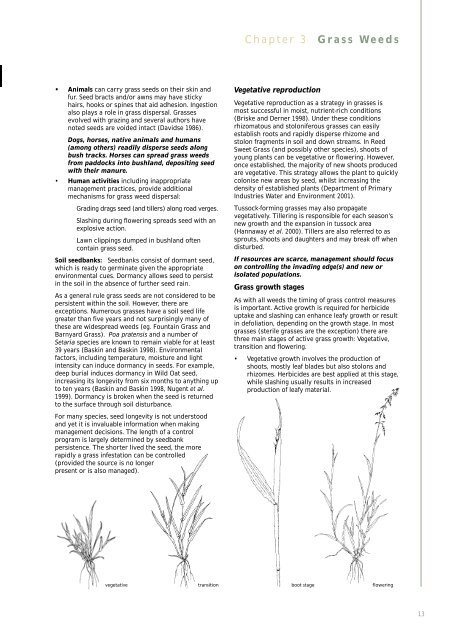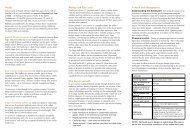Bushland Weeds Manual - Environmental Weeds Action Network
Bushland Weeds Manual - Environmental Weeds Action Network
Bushland Weeds Manual - Environmental Weeds Action Network
You also want an ePaper? Increase the reach of your titles
YUMPU automatically turns print PDFs into web optimized ePapers that Google loves.
• Animals can carry grass seeds on their skin and<br />
fur. Seed bracts and/or awns may have sticky<br />
hairs, hooks or spines that aid adhesion. Ingestion<br />
also plays a role in grass dispersal. Grasses<br />
evolved with grazing and several authors have<br />
noted seeds are voided intact (Davidse 1986).<br />
Dogs, horses, native animals and humans<br />
(among others) readily disperse seeds along<br />
bush tracks. Horses can spread grass weeds<br />
from paddocks into bushland, depositing seed<br />
with their manure.<br />
• Human activities including inappropriate<br />
management practices, provide additional<br />
mechanisms for grass weed dispersal:<br />
Grading drags seed (and tillers) along road verges.<br />
Slashing during flowering spreads seed with an<br />
explosive action.<br />
Lawn clippings dumped in bushland often<br />
contain grass seed.<br />
Soil seedbanks: Seedbanks consist of dormant seed,<br />
which is ready to germinate given the appropriate<br />
environmental cues. Dormancy allows seed to persist<br />
in the soil in the absence of further seed rain.<br />
As a general rule grass seeds are not considered to be<br />
persistent within the soil. However, there are<br />
exceptions. Numerous grasses have a soil seed life<br />
greater than five years and not surprisingly many of<br />
these are widespread weeds (eg. Fountain Grass and<br />
Barnyard Grass). Poa pratensis and a number of<br />
Setaria species are known to remain viable for at least<br />
39 years (Baskin and Baskin 1998). <strong>Environmental</strong><br />
factors, including temperature, moisture and light<br />
intensity can induce dormancy in seeds. For example,<br />
deep burial induces dormancy in Wild Oat seed,<br />
increasing its longevity from six months to anything up<br />
to ten years (Baskin and Baskin 1998, Nugent et al.<br />
1999). Dormancy is broken when the seed is returned<br />
to the surface through soil disturbance.<br />
For many species, seed longevity is not understood<br />
and yet it is invaluable information when making<br />
management decisions. The length of a control<br />
program is largely determined by seedbank<br />
persistence. The shorter lived the seed, the more<br />
rapidly a grass infestation can be controlled<br />
(provided the source is no longer<br />
present or is also managed).<br />
Chapter 3 Grass <strong>Weeds</strong><br />
Vegetative reproduction<br />
Vegetative reproduction as a strategy in grasses is<br />
most successful in moist, nutrient-rich conditions<br />
(Briske and Derner 1998). Under these conditions<br />
rhizomatous and stoloniferous grasses can easily<br />
establish roots and rapidly disperse rhizome and<br />
stolon fragments in soil and down streams. In Reed<br />
Sweet Grass (and possibly other species), shoots of<br />
young plants can be vegetative or flowering. However,<br />
once established, the majority of new shoots produced<br />
are vegetative. This strategy allows the plant to quickly<br />
colonise new areas by seed, whilst increasing the<br />
density of established plants (Department of Primary<br />
Industries Water and Environment 2001).<br />
Tussock-forming grasses may also propagate<br />
vegetatively. Tillering is responsible for each season’s<br />
new growth and the expansion in tussock area<br />
(Hannaway et al. 2000). Tillers are also referred to as<br />
sprouts, shoots and daughters and may break off when<br />
disturbed.<br />
If resources are scarce, management should focus<br />
on controlling the invading edge(s) and new or<br />
isolated populations.<br />
Grass growth stages<br />
As with all weeds the timing of grass control measures<br />
is important. Active growth is required for herbicide<br />
uptake and slashing can enhance leafy growth or result<br />
in defoliation, depending on the growth stage. In most<br />
grasses (sterile grasses are the exception) there are<br />
three main stages of active grass growth: Vegetative,<br />
transition and flowering.<br />
• Vegetative growth involves the production of<br />
shoots, mostly leaf blades but also stolons and<br />
rhizomes. Herbicides are best applied at this stage,<br />
while slashing usually results in increased<br />
production of leafy material.<br />
vegetative transition boot stage<br />
flowering<br />
13



